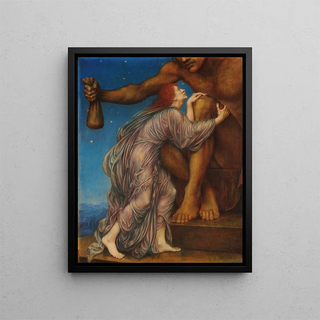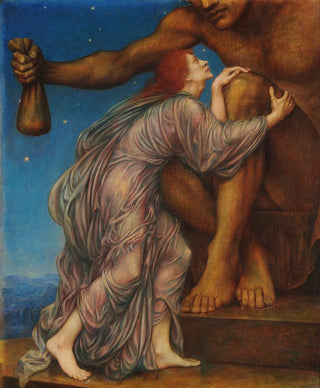Art print The Cult of Mammon - Evelyn De Morgan


View from behind

Frame (optional)
Art print Le Culte de Mammon - Evelyn De Morgan – Engaging Introduction
In a world where art and spirituality intersect, "Le Culte de Mammon" by Evelyn De Morgan stands out as an iconic piece, revealing the internal struggles of the human soul in the face of material temptations. This canvas, charged with emotional intensity, invites viewers to explore themes of greed and morality. Through a composition rich in symbolism, the artist immerses us in a universe where the desire for wealth and power is highlighted, while also emphasizing the disastrous consequences of this pursuit. The depiction of Mammon, the mythological figure of greed, embodies this struggle between spiritual aspiration and earthly temptations, offering a profound reflection on the human condition.
Style and uniqueness of the work
The uniqueness of "Le Culte de Mammon" lies in Evelyn De Morgan's distinctive style, which skillfully blends Pre-Raphaelitism and Victorian aesthetics. The vibrant colors and meticulous details of this piece catch the eye and evoke immediate admiration. De Morgan uses rich hues and striking contrasts to create an atmosphere that is both enchanting and unsettling. The human figures, beautifully rendered, seem almost alive, touching the viewer with their expressive, meaningful faces. The artist also plays with light and shadow to emphasize the drama of the scene, highlighting the struggle between good and evil. This unique stylistic approach allows the artwork to transcend time, continuing to question and inspire those who contemplate it.
The artist and her influence
Evelyn De Morgan, a prominent figure of the late 19th-century artistic movement, established herself as an original voice within an art scene dominated by her male contemporaries. Her passion for spiritual and mythological themes led her to create works that question the values of her era. Influenced by currents such as Pre-Raphaelitism, she also incorporated elements of philosophy and theology into her creations. De Morgan often addressed topics related to women's rights and the emancipation of women, making her a pioneering figure in her field.

Matte finish

View from behind

Frame (optional)
Art print Le Culte de Mammon - Evelyn De Morgan – Engaging Introduction
In a world where art and spirituality intersect, "Le Culte de Mammon" by Evelyn De Morgan stands out as an iconic piece, revealing the internal struggles of the human soul in the face of material temptations. This canvas, charged with emotional intensity, invites viewers to explore themes of greed and morality. Through a composition rich in symbolism, the artist immerses us in a universe where the desire for wealth and power is highlighted, while also emphasizing the disastrous consequences of this pursuit. The depiction of Mammon, the mythological figure of greed, embodies this struggle between spiritual aspiration and earthly temptations, offering a profound reflection on the human condition.
Style and uniqueness of the work
The uniqueness of "Le Culte de Mammon" lies in Evelyn De Morgan's distinctive style, which skillfully blends Pre-Raphaelitism and Victorian aesthetics. The vibrant colors and meticulous details of this piece catch the eye and evoke immediate admiration. De Morgan uses rich hues and striking contrasts to create an atmosphere that is both enchanting and unsettling. The human figures, beautifully rendered, seem almost alive, touching the viewer with their expressive, meaningful faces. The artist also plays with light and shadow to emphasize the drama of the scene, highlighting the struggle between good and evil. This unique stylistic approach allows the artwork to transcend time, continuing to question and inspire those who contemplate it.
The artist and her influence
Evelyn De Morgan, a prominent figure of the late 19th-century artistic movement, established herself as an original voice within an art scene dominated by her male contemporaries. Her passion for spiritual and mythological themes led her to create works that question the values of her era. Influenced by currents such as Pre-Raphaelitism, she also incorporated elements of philosophy and theology into her creations. De Morgan often addressed topics related to women's rights and the emancipation of women, making her a pioneering figure in her field.
12,34 €






